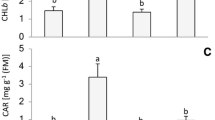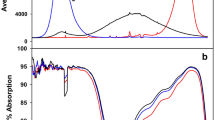Abstract
Photochemical features of thylakoid membranes and chlorophyll content were investigated in two pea (Pisum sativum L.) cultivars with different leaf colouration: ‘Assas’ (red leaves) and ‘Arvika’ (green leaves). In vivo measured chlorophyll fluorescence (OJIP) was used to evaluate overall photosynthetic efficiency (expressed as performance index, PIABS) as well as for advanced analysis of main photochemical processes per active reaction centre (RC) of photosystem II (PSII). To evaluate the response of PSII driven linear electron transport (relETR) and non-photochemical quenching (NPQ), the plants were challenged with short-term high light (~2000 µmol m−2 s−1). In spite of prevailing red colour, leaves of ‘Assas’ had identical concentrations of chlorophylls a and b as green ones. The OJIP transients showed that red leaves grown in field (500–800 µmol m−2 s−1) had decreased PIABS and electron transport per RC beyond primary acceptor (Q −A ) compared to green leaves. After high light exposure red leaves revealed impaired relETR accompanied with increased NPQ values. Anthocyanins located in epidermal cells affected neither chlorophylls concentrations nor the light capture features of PSII. Despite equal concentrations of chlorophylls and PSII photochemistry further than Q −A in both leaf types, red leaves reduced overall photosynthetic efficiency due to impaired relETR in thylakoid membranes.






Similar content being viewed by others
References
Allen DJ, Ort DR (2001) Impacts of chilling temperatures on photosynthesis in warm-climate plants. Trends Plant Sci 6:36–42. doi:10.1016/S1360-1385(00)01808-2
Bolhar-Nordenkampf HR, Long SP, Baker NR, Öquist G, Schreiber U, Lechner EG (1989) Chlorophyll fluorescence as a probe of the photosynthetic competence of leaves in the field: a review of current instrumentation. Funct Ecol 3:497–514. doi:10.2307/2389624
Burger J, Edwards GE (1996) Photosynthetic efficiency, and photodamage by UV and visible radiation, in red versus green leaf coleus varieties. Plant Cell Physiol 37:395–399
Cooney LJ, Schaefer HM, Logan BA, Cox B, Gould KS (2015) Functional significance of anthocyanins in peduncles of Sambucus nigra. Environ Exp Bot 119:18–26. doi:10.1016/j.envexpbot.2015.03.001
Das PK, Geul B, Choi S-B, Yoo S-D, Park Y-I (2011) Photosynthesis-dependent anthocyanin pigmentation in Arabidopsis. Plant Signal Behav 6:23–25. doi:10.4161/psb.6.1.14082
Dewez D, Perreault F (2013) Effect of the anthocyanic epidermal layer on Photosystem II and I energy dissipation processes in Tradescantia pallida (Rose) Hunt. Acta Physiol Plant 35:463–472. doi:10.1007/s11738-012-1089-5
Fondom NY, Castro-Nava S, Huerta AJ (2009) Photoprotective mechanisms during leaf ontogeny: cuticular development and anthocyanin deposition in two morphs of Agave striata that differ in leaf coloration. Botany 87:1186–1197. doi:10.1139/B09-076
Gould KS (2004) Nature’s Swiss army knife: the diverse protective roles of anthocyanins in leaves. J Biomed Biotechnol 5:314–320. doi:10.1155/S1110724304406147
Gould KS, Dudle DA, Neufeld HS (2010) Why some stems are red: cauline anthocyanins shield photosystem II against high light stress. J Exp Bot 61:2707–2717. doi:10.1093/jxb/erq106
Hatier J-HB, Gould KS (2009) Anthocyanins function in vegetative organs. In: Gould K, Davies K, Winefield C (eds) Anthocyanins. Biosynthesis, functions, and applications. Springer Science + Business Media, New York, pp 1–21. doi:10.1007/978-0-387-77335-3
Hatier JHB, Clearwater MJ, Gould KS (2013) The functional significance of black-pigmented leaves: photosynthesis, photoprotection and productivity in Ophiopogon planiscapus ‘Nigrescens’. PLoS ONE 8:e67850. doi:10.1371/journal.pone.0067850
Hughes NM, Lev-Yadun S (2015) Red/purple leaf margin coloration: potential ecological and physiological functions. Environ Exp Bot 119:27–39. doi:10.1016/j.envexpbot.2015.05.015
Hughes NM, Smith WK (2007) Attenuation of incident light in Galax urceolata (Diapensiaceae): concerted influence of adaxial and abaxial anthocyanic layers on photoprotection. Am J Bot 94:784–790. doi:10.3732/ajb.94.5.784
Hughes NM, Carpenter KL, Keidel TS, Miller CN, Waters MN, Smith WK (2014) Photosynthetic costs and benefits of abaxial versus adaxial anthocyanins in Colocasia esculenta ‘Mojito’. Planta 240:971–981. doi:10.1007/s00425-014-2090-6
Kalaji HM, Govindjee Bosa K, Koscielniak J, Zuk-Golaszewska K (2011) Effects of salt stress on photosystem II efficiency and CO2 assimilation of two Syrian barley landraces. Environ Exp Bot 73:64–72. doi:10.1016/j.envexpbot.2010.10.009
Landi M, Guidi L, Pardossi A, Tattini M, Gould K (2014) Photoprotection by foliar anthocyanins mitigates effects of boron toxicity in sweet basil (Ocimum basilicum). Planta 240:941–953. doi:10.1007/s00425-014-2087-1
Landi M, Tattini M, Gould KS (2015) Multiple functional roles of anthocyanins in plant-environment interactions. Environ Exp Bot 119:4–17. doi:10.1016/j.envexpbot.2015.05.012
Lebkuecher JG, Haldeman KA, Harris CE, Holz SL, Joudah SA, Minton DA (1999) Development of photosystem-II activity during irradiance of etiolated Helianthus (Asteraceae) seedlings. Am J Bot 86:1087–1092
Liakopoulos G, Nikolopoulos D, Klouvatou A, Vekkos KA, Manetas Y, Karabourniotis G (2006) The photoprotective role of epidermal anthocyanins and surface pubescence in young leaves of grapevine (Vitis vinifera). Ann Bot 98:257–265. doi:10.1093/aob/mcl097
Lichtenthaler HK (1987) Chlorophylls and carotenoids: pigments of photosynthetic biomembranes. Method Enzymol 148:350–382. doi:10.1016/0076-6879(87)48036-1
Manetas Y (2006) Why some leaves are anthocyanic and why most anthocyanic leaves are red? Flora (Jena) 201:163–177. doi:10.1016/j.flora.2005.06.010
Merzlyak MN, Chivkunova OB, Solovchenko AE, Naqvi KR (2008) Light absorption by anthocyanins in juvenile, stressed, and senescing leaves. J Exp Bot 59:3903–3911. doi:10.1093/jxb/ern230
Müller P, Li X-P, Niyogi KK (2001) Non-photochemical quenching. A response to excess light energy. Plant Physiol 125:1558–1566. doi:10.1104/pp.125.4.1558
Munier-Jolain N, Biarnès V, Chaillet I, Lecoeur J, Jeuffroy M-H (2010) Physiology of the pea crop. CRC Press, Boca Raton
Osorio ML, Osorio J, Romano A (2013) Photosynthesis, energy partitioning, and metabolic adjustments of the endangered Cistaceae species Tuberaria major under high temperature and drought. Photosynthetica 51:75–84
Peng CL, Lin ZF, Lin GH, Chen SW (2006) The anti-photooxidation of anthocyanins-rich leaves of a purple rice cultivar. Sci China Ser C 49:543–551. doi:10.1007/s11427-006-2022-1
Pereira WE, de Siqueira DL, Martínez CA, Puiatti M (2000) Gas exchange and chlorophyll fluorescence in four citrus rootstocks under aluminium stress. J Plant Physiol 157:513–520. doi:10.1016/S0176-1617(00)80106-6
Ranjan S, Singh R, Singh M, Pathre UV, Shirke PA (2014) Characterizing photoinhibition and photosynthesis in juvenile-red versus mature-green leaves of Jatropha curcas L. Plant Physiol Biochem 79:48–59. doi:10.1016/j.plaphy.2014.03.007
Schreiber U, Bilger W, Neubauer C (1994) Chlorophyll fluorescence as a nonintrusive indicator of rapid assessment of in vivo photosynthesis. In: Schulze ED, Caldwell MM (eds) Ecophysiology of photosynthesis: ecological studies. Springer, Berlin, pp 49–70
Shao L, Shu Z, Peng C, Lin Z, Yang C, Gu Q (2008) Enhanced sensitivity of Arabidopsis anthocyanin mutants to photooxidation: a study with fluorescence imaging. Funct Plant Biol 35:714–724. doi:10.1071/FP08069
Solovchenko AE, Chivkunova OB (2011) Physiological role of anthocyanin accumulation in common hazel juvenile leaves. Russ J Plant Physiol 58:674–680. doi:10.1134/S1021443711040157
Steyn WJ, Wand SJE, Holcroft DM, Jacobs G (2002) Anthocyanins in vegetative tissues: a proposed unified function in photoprotection. New Phytol 155:349–361. doi:10.1046/j.1469-8137.2002.00482.x
Steyn WJ, Wand SJE, Jacobs G, Rosecrance RC, Roberts SC (2009) Evidence for a photoprotective function of low-temperature-induced anthocyanin accumulation in apple and pear peel. Physiol Plant 136:461–472
Štolfa I, Lepeduš H, Cesar V, Ljubešić N (2006) Leaf anatomy and photosynthetic apparatus functioning of red and green laeves from single tre of “Crimson King” Norway maple. In: Gajović S (ed) Proceedings of 2nd Croatian Congress on Microscopy with International Participation, Topusko, Croatia, 18–21 May 2006. Hrvatsko društvo za elektronsku mikroskopiju, Zagreb, pp 212–213
Strasser RJ, Srivastava A, Tsimilli-Michael M (2000) The fluorescence transient as a tool to characterize and screen photosynthetic samples. In: Yunus M, Pathre U, Mohanty P (eds) Probing photosynthesis: mechanism, regulation & adaptation, 1st edn. CRC, New York, pp 445–483
Strasser RJ, Tsimilli-Michael M, Srivastava A (2004) Analysis of the chlorophyll a fluorescence transient. In: Papageorgiou GC, Govinjee (eds) Chlorophyll a fluorescence: a signature of photosynthesis, vol 19. Springer, Dordrecht, pp 321–362
Takahashi S, Badger MR (2011) Photoprotection in plants: a new light on photosystem II damage. Trends Plant Sci 16:53–60. doi:10.1016/j.tplants.2010.10.001
Tanino KK, Cherry KM, Kriger JN, Hrycan W, Marufu G, Thomas JD, Gray GR (2014) Photosynthetic responses to temperature-mediated dormancy induction in contrasting ecotypes of red-osier dogwood (Cornus sericea L.). Environ Exp Bot 106:221–230. doi:10.1016/j.envexpbot.2014.02.015
Tattini M, Landi M, Brunetti C, Giordano C, Remorini D, Gould KS, Guidi L (2014) Epidermal coumaroyl anthocyanins protect sweet basil against excess light stress: multiple consequences of light attenuation. Physiol Plant 152:585–598. doi:10.1111/ppl.12201
Tsormpatsidis E, Henbest RGC, Battey NH, Hadley P (2010) The influence of ultraviolet radiation on growth, photosynthesis and phenolic levels of green and red lettuce: potential for exploiting effects of ultraviolet radiation in a production system. Ann Appl Biol 156:357–366. doi:10.1111/j.1744-7348.2010.00393.x
Yusuf MA, Kumar D, Rajwanshi R, Strasser RJ, Tsimilli-Michael M, Govindjee Sarin NB (2010) Overexpression of γ-tocopherol methyl transferase gene in transgenic Brassica juncea plants alleviates abiotic stress: physiological and chlorophyll a fluorescence measurements. Biochim Biophys Acta 1797:1428–1438. doi:10.1016/j.bbabio.2010.02.002
Acknowledgments
Financial support for the work was provided by the Croatian Ministry of Science, Education and Sport (Grants 073-0731674-1673 to HL, 073-0000000-3535 to SP and 073-0731674-0841 to VC).
Author information
Authors and Affiliations
Corresponding author
Additional information
Selma Mlinarić and Hrvoje Lepeduš have contributed equally to this work.
Rights and permissions
About this article
Cite this article
Mlinarić, S., Čupić, T., Popović, S. et al. Photochemistry of thylakoid membranes in two pea cultivars with different leaf colouration. Theor. Exp. Plant Physiol. 29, 13–24 (2017). https://doi.org/10.1007/s40626-016-0082-6
Received:
Accepted:
Published:
Issue Date:
DOI: https://doi.org/10.1007/s40626-016-0082-6




